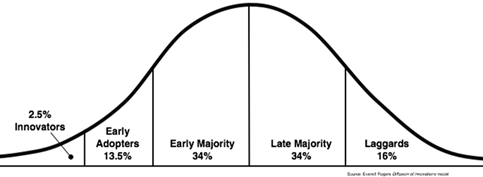
The momentum of innovation has been picking up for decades, and at this point, there’s no stopping it. Changes that used to take years to come to fruition can now be achieved in a matter of weeks. So, you have two options: Embrace it and ride it to success or try to stand in the way and get run over.
We live in a tech-driven world. Technology is no longer reserved for the more traditionally innovative industries. It is now table stakes for every industry (including the public sector) to be proactive about using technology to address their core needs.
The need to adopt a tech-forward mindset may seem stressful to some people. This is because it can be uncomfortable to learn new skillsets and compete on a playing field that may feel unfamiliar. But I’d encourage you to take another approach and lean into the excitement of this momentum and change.
Let me make the case for why government agencies and public servants should definitely hop on board.
Why This Matters: The Diffusion of Innovation Theory
Let’s start with a little healthy urgency.
The adoption curve for technology in the government sector is widening the gap between innovative and non-innovative agencies. This is illustrated by the well-known Diffusion of Innovation Theory, illustrated below.

The reaction window – i.e. the amount of time between when innovation is introduced and when you take action on it – is shortening, meaning that laggards are falling behind at the same pace that innovators are getting ahead.
If you fall into the Laggards category, you are likely adopting technology that is already outdated. So, an immediate start – even if you’re a little uncomfortable with change – will give you a massive leg up.
The public sector has had massive opportunity to optimize and create positive change but has traditionally been very slow to adopt technology. And waiting too long to take action can be extremely damaging for your agency and your constituents.
What’s At Risk When It Comes to Government Agencies
As mentioned before, government agencies may be especially vulnerable to the downsides of this theory due to their resistance to change.
While this hesitation may be warranted – because of bureaucratic red tape, limited resources, limited in-house IT resources, and the complexity of implementing large-scale changes in established systems, or any variety of these reasons – it doesn’t mean that you should treat it like a stop light.
There are a variety of risks associated with hanging onto antiquated systems while keeping innovation at arm’s length, including:
- Extra man-hours required to run clunky systems
- Increased employee turnover and decreased interest in the field since the upcoming workforce is highly tech-savvy
- The inability to adapt to a hybrid or remote environment where cloud-based platforms are mandatory
- For platforms that the public interacts with, you’re also stealing valuable time away from communities in need by not being user-friendly
All the risks accumulate into one, overarching risk: you’re sabotaging the well-being of your organization, constituents, and whole communities. With all these inefficiencies, your team’s ability to make changes is a much harder feat.
Additionally, the longer these risks persist, the larger the gap becomes between the private and public sectors. One of the biggest pitfalls of this, that the public sector knows well, is finding and retaining qualified talent. How much time and resources are wasted finding, recruiting, and training workers just to have them leave after a short period because they found a more satisfying job elsewhere?
The First Step to Overcoming This Challenge is Cultural
Many government organizations have a legacy of being “old-fashioned” engrained in their DNA. This tendency to accept inefficient software because it’s the way things have always been done is often the largest barrier to innovation.
That’s why it takes intentional and strategic change from a management level to overcome this legacy and get the team on board for a more innovative way of working. So, before you start tearing down your processes, you need to nurture this culture and create a morale that embraces change, not one that runs from it.
Clearly lay out how the technology you’re looking to adopt will solve key problems with efficiency, reliability, and accuracy.
For government employees who have been apprehensive about change, presenting this as an opportunity to focus on the community instead of tedious tasks is typically highly effective. Once they’re able to see how the resulting boost in efficiency can give them more time to focus on the work that they care about, excitement typically pushes the worry and resistance to the side.
GovTech Helps Organizations Keep Pace
Government agencies aren’t in this alone. There are several GovTech companies that have custom-built solutions for complex and high-stake problems that are unique to specific portions of the public sector. That means your team doesn’t need to invest tons of time and money building a custom solution or try to fit public sector pains into a solution built for the private sector. A GovTech company somewhere has most likely already built a software solution targeting all you specific pains, needs and requirements.
To name a few:
- GovPilot is a government management software that’s revolutionized the way local and federal governments handle their administrative tasks by streamlining processes and improving efficiency.
- Workday is a cloud-based enterprise management system adopted by numerous public organizations to enhance their human resource functions and overall operational effectiveness
- Neighborly Software is the first of its kind to enable governments to better assist their communities by streamlining the management of their HUD and Treasury resources, applicant waitlists, and disbursement funds through its platform.
Ride on the Coattails of Innovation, Don’t Get Run Over.
With so much at stake and with so many new technologies out there to revolutionize the way you work, it’s almost a no-brainer to embrace the innovation that’s at hand now. The quicker you jump on board, the quicker you reap the rewards and distance yourself from the processes and technologies of yesterday.
If you’re looking for a HUD solution to help you save time and resources and put you at the forefront of innovative technology in your field, give Neighborly a try. To see what different our software has made in other government agencies, check out our library of case studies.









